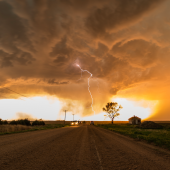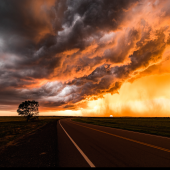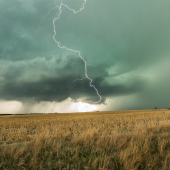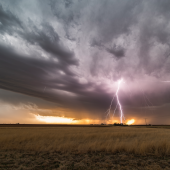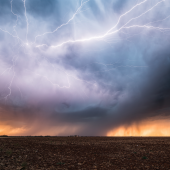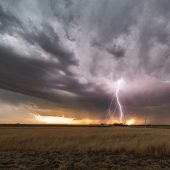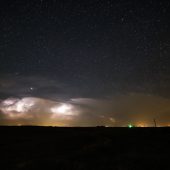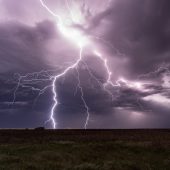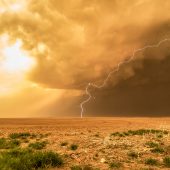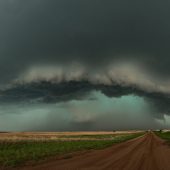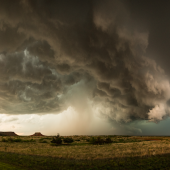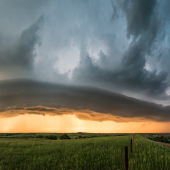Interview with real storm hunter and photographer Guillaume Hobam on using the Irix 15mm f/2.4 full frame DSLR lens ($425-$575):
Why did you choose such a domain – that is, taking pictures of tornadoes?
I’ve always been passionate about nature, the environment, and the planet ever since I was young. At the age of four (in 1999), there was this very violent storm that crossed over France. This was a pretty memorable storm, with wind speeds over 150 kilometres an hour in my area, but peaking at 200 kilometres an hour… not unlike the famous movie Twister released in 1996 and known worldwide!
My parents tell me that it was from that moment that I started to become passionate about meteorology. I would live out other moments during my childhood with thunderstorms that were particularly violent in my area… From 12 years of age, I became self-taught in meteorology using sites such as, for example, Meteociel.fr or infoclimat.fr and plenty of others. I’m particularly interested in the predictions of violent phenomena as well as winter phenomena, all thanks to numerical prediction models with computers roughly calculating billions of data in real time to make prediction maps over several days. These prediction models have evolved enormously in the last ten years with forecasts being more and more precise in areas, and being increasingly reliable too.

In 2011, while having exchanges on a meteorological forum with other enthusiasts, I met Kevin Leclercq, a young man of my age who lived just a few kilometres from my home near Nancy. He is just as passionate as me! We got to know each other better before embarking on our very first “storm hunt” with the help of his cousin, who had a car to get us around because doing a car-less storm hunt is almost mission impossible!
Kevin obtained his driving licence in 2012 which allowed us to make our first real hunts in our region, but that year will remain perhaps one of the most violent phenomena that I’ve ever experienced in France. It was the storm of the century in Nancy, in my city! The equivalent of two months rain fell in just the one hour above my head. Unfortunately, there was a one-metre torrent of water crossing my street which made it impossible for me to track down this storm of the century.
Then in 2013, when I was one month past my eighteenth birthday, I got my license and so the hunt for “national” storms opened up for me and Kevin. Now we both go to different regions of France, travelling thousands of kilometres, just to indulge in our passion!
I quickly joined a group of storm hunters called “Alsace – Lorraine stormchasers”. We’re a group of around twenty passionate storm trackers and we share our photos on a Facebook page assigned Alsace – Lorraine Chasseurs d’Orages / Météo.. Then in 2015, with some of the active members of the group, we decided to create an association in order to become recognized legally. I formulated the association while being in the office, most particularly in my role as “Secretary”. Then in 2016, the president decided to leave the association for personal reasons. Being a particularly active member, I decided to put myself forward for the candidacy of president and, low and behold, became the president of the association! I joyfully preside in my role and all my free time is taken up with our group. I’m busy with taking care of our Facebook page, and in that time seen the number of subscribers explode; we went from 2000, which I was pretty happy with, to more than 20,000 now!

In 2017, I decided to embark on a “European” thunderstorm fighters tour with a passionate friend like me, from Lyon, especially to track thunderstorms in other places besides France. We covered thousands of kilometres across Italy (a great area for storms, tornadoes and waterspouts), as well as the Balkans, which are renowned for particularly strong storms and having the aesthetics for lightning when the cold air of the months of August and September descend into the region. This creates a massive conflict of air and so creates those big storms.
Now this year’s going to be remarkable for me in that it’s going to be the year when I observe my first vortex phenomena, that is, those waterspouts that reach the land from the water and thus becomes a tornado. I’ve observed these phenomena in Croatia and in Italy.
These “European” thunderstorm huntings have led me to a few things, including preparation for the violent phenomena that occur on the Great Plains of the United States, and at the end of 2017 we’d been preparing with two friends – both French storm hunters – our first big trip into the infamous Tornado Alley for 2018. And after several weeks of preparation, we were off to the USA for six weeks of stormy tornado tracking.

How would you describe this kind of photography?
I’d say it’s a unique kind of photography. It’s intense, tiring and full of adrenaline, but for storm hunters, the storm is the fuel for the body. It’s amazing the good that it does to us internally… maybe it’s the strength and the energy of nature that fuels us a little? That is the question… This is a kind of photography that’s quite unusual; it’s particularly dangerous because we must be well aware of the risks that this represents.

What would you recommend?
We don’t become storm hunters overnight. I’m even convinced that we shouldn’t even become so if we don’t have any knowledge of meteorology since it is a climatic phenomenon that’s already very complicated to predict. But because we don’t know meteorology, then this makes things even more complicated, if not impossible. This can be a waste of time and money for amateurs who want to start out on this kind of photography and then find it particularly difficult to achieve anything, especially when it comes to shooting techniques as well as forecasting this climatic phenomenon; it’s still difficult to predict.

What would you recommend to photographers who want to start out on this type of photography?
I strongly believe that it’s best to have the minimum amount of knowledge required in meteorology and weather forecasting before starting out on this type of photography. Learning meteorology can’t be picked up overnight; it takes long years of practice on the internet and being self-taught both on meteorology forums and on sites where digital models are freely available such as “meteociel.fr” , which brings together numerical forecasting models for many countries in Europe and around the world.
It is also, above all, having that passion in your blood. I think we have to have that in our skin because every cloud, every storm, every intense weather situation cannot prevent us from looking at what is happening in the sky.

Describe and explain five tips on how to take beautiful tornado photographs.
The best ways to take beautiful photographs of tornadoes and thunderstorms is having the knowledge as regards storm phenomena, because the tornado occurs in a specific place in the storm. It’s then necessary to be well placed geographically in relation to the storm as well as being in relation to its trajectory; we mustn’t forget that a storm can move at a relatively fast speed and we have to anticipate this.

Now what about three tips for doing tornado photography in wide angle?
Three tips for making tornado photography in wide angle? Well…
– Being closer to the tornado without being in danger!
– Make a good prediction before the hunt to be well placed before the thunderstorms begin.
– Pay attention to those drops that can fall on the lens because in general the rain is not very far behind the tornado!

How did you get the idea of a six-week trip to the United States?
The United States is the Mecca for all storm hunters around the world. It’s the best area in the world that is conducive to the formation of a thousand tornadoes every year. Between the hot and humid air coming up from the Gulf of Mexico, the warm, dry air coming down from the rocks and the cold, dry air coming down from Canada, it’s a huge air mass conflict; it’s what is more specifically called the “triple point”, a place conducive to an accumulation of violent storms with several tornadoes between the months of April to June in what has come to be known as Tornado Alley.
I wanted to have gotten enough experience in France and Europe before going off to hunt for these storms out into the ordinary US, having taken me more than ten years of accumulated knowledge in meteorology and more than five years of storm tracking in France and in Europe before making such a trip because… well, it’s going to be very tiring with these hundreds of kilometres per day. In the 42 days we made our presence, we covered a total of 30 000 km across New Mexico, Texas, Colorado, Kansas, Nebraska, Iowa, South Dakota, Nebraska, Wyoming …

Did you have any plans to change things once you encountered the reality there? Why and how?
As it was our first trip to Tornado Alley apprehension was palpable. We thought it was going to give us some problems, what with all the camera equipment or laptops that could crash on us, problems with the car leasing, problems with numerical forecasting models, problems with live maps (real-time radar and lightning maps) or problems with organizations. But thankfully there were no particular problems on this long journey, which is relatively incredible when you consider the length of the trip and the number of kilometres we’ve covered!

What impressed you most about this trip?
Well, I have to say that these American storms are from another dimension when you compare them to those in Europe. Those deserted cities in Texas as well as in New Mexico are particularly scary, and also those farm fields with thousands of cows.
All of these elements are somewhat disproportionate in the USA …

What is your favourite picture and why?
My favourite photo taken with the Irix 15mm is this exceptional sunset. I’ve never lived a moment that was so intense and with such strong colours. And this road – it gives such a depth of field in the foreground with the sun piercing this rain curtain. This photo has no colour saturation. This image will always remain with me.

If you had the chance to repeat such a trip, what would you change / add?
I wouldn’t change a thing for the next trip. I’d stay with my friends, the same friends and the same organization we’d had for this long journey of six weeks. Everything went perfectly well. Unfortunately we experienced the least stormiest year of the last thirty years, and, of course, the one where there has been the least number of tornadoes for decades…
Despite the worst stormy season (in terms of hunting, of course!) for decades, we still had storms daily – sometimes violent – and we mustn’t forget that we tracked ten tornadoes in total, a very good record given the weather situation there… but a very bad tornado season for seasoned storm hunters!
The next few years will be much better, and I intend to return as soon as possible!

How do you use the Irix 15mm? For what purpose?
The wide angle lens is an essential element in this field of photography, because when the storm is near, it’s essential to have the widest possible angle to be able to take its cloud structure and the possible lightning.
The Irix 15mm is the ideal wide-angle lens for storm hunters, with a very good dive and very even at the edges. Why is it ideal? Because its external lens is very indented compared to the sun visor. When the storm’s very close, we use the wide angle lens because we have no choice; when the storm’s near, the first drops of rain fall … I had the opportunity to test many a wide angle, and the majority of these wide-angle lenses have aspherical lenses so they’re very curved. The lens almost exceeds the sun visor on some lenses. On the Irix 15mm, the lens is so small and set back from the sun visor that the raindrops reach it only very rarely, which is a big plus when we want to take photographs of very similar lightning. I therefore advise all budding storm hunters to acquire this piece of kit in order to try out their abilities under thunderstorms…
If you have an interesting idea for a guest post, you can contact me here.
Additional information on Irix lenses can be found here.
Irix lenses are sold at Amazon US | Amazon UK | Amazon DE | Amazon FR | Amazon IT.


